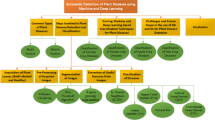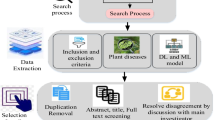Abstract
The detection of plant disease is an important problem that requires concentrating on the effective production of agriculture and the economy. The traditional techniques were used to detect this plant disease, but it is a difficult task that needs a lot of time, work, and expertise. The recent research gathered more attention recently between researchers, practitioners, and academicians called automatic detection of plant disease. This automation uses two techniques called machine learning and deep learning that helps for the identification of plant disease at the earlier stage as it finds in leaves of plants. A complete examination was done for the evaluation using the modern study on the possibility of acquiring the machine learning models to find the plant disease. There are four methods of diseases and infection on crops. Primarily, various possible diseases and infections on various crop types are investigated with the cause for the happening and feasible symptoms for the identifications. A thorough investigation on the various pace is needed that is evolved in the detection of plant disease and the categorization with the help of deep learning and machine learning that are given. Different datasets that are there in online to detect plant disease are also provided. A complete investigation regarding different machine learning and deep learning depending on the classification models is discussed, which are given previously and are suggested over the world by various researches for the four above-mentioned crops related to the evaluation on performance, the used dataset, and the method of feature extraction. Finally, different difficulties are listed and presented when using machine learning and deep learning techniques to identify the plant disease and present the future research scope.
Access this chapter
Tax calculation will be finalised at checkout
Purchases are for personal use only
Similar content being viewed by others
References
Atoum Y, Afridi MJ, Liu X, McGrath JM, Hanson LE (2016) On developing and enhancing plant-level disease rating systems in real fields. Pattern Recogn 53:287–299
Chen L, Wang R, Yang J, Xue L, Hu M (2019) Multi-label image classification with recurrently learning semantic dependencies. Vis Comput 35(10):1361–1371
Ferentinos KP (2018) Deep learning models for plant disease detection and diagnosis. Comput Electron Agric 145:311–318
Guan W, Sun Y, Wang J (2017) Automatic image-based plant disease severity estimation using deep learning. Comput Intell Neurosci 2017:2917536
He N, Wang T, Chen P, Yan H, Jin Z (2018) An android malware detection method based on deep autoencoder. In: Proceedings of the 2018 artificial intelligence and cloud computing conference, pp 88–93
Hu J, Shen L, Sun G (2018) Squeeze-and-excitation networks. In: Proceedings of the IEEE conference on computer vision and pattern recognition, pp 7132–7141
Ji M, Zhang L, Wu Q (2019) Automatic grape leaf diseases identification via united model based on multiple convolutional neural networks. Inf Process Agric. https://doi.org/10.1016/j.inpa.2019.10.003
Lee J, Seo W, Park JH, Kim DW (2019) Compact feature subset-based multi-label music categorization for mobile devices. Multimed Tools Appl 78(4):4869–4883
Pouyanfar S, Wang T, Chen SC (2019) A multi-label multimodal deep learning framework for imbalanced data classification. In: 2019 IEEE conference on multimedia information processing and retrieval (MIPR), pp 199–204
Sun H, Wei J, Zhang J, Yang W (2014) A comparison of disease severity measurements using image analysis and visual estimates using a category scale for genetic analysis of resistance to bacterial spot in tomato. Eur J Plant Pathol 139(1):125–136
Zhang Z, Hong WC (2019) Electric load forecasting by complete ensemble empirical mode decomposition adaptive noise and support vector regression with quantum-based dragonfly algorithm. Nonlinear Dyn 98(2):1107–1136
Zoph B, Vasudevan V, Shlens J, Le QV (2018) Learning transferable architectures for scalable image recognition. In: Proceedings of the IEEE conference on computer vision and pattern recognition, pp 8697–8710
Canizares MC, Rosas-Diaz T, Rodriguez-Negrete E, Hogenhout SA, Bedford ID, Bejarano ER, Navas-Castillo J, Moriones E (2015) Arabidopsis thaliana, an experimental host for tomato yellow leaf curl disease-associated begomoviruses by agroinoculation and whitefly transmission. Plant Pathol 64:265–271
Fuentes A, Yoon S, Youngki H, Lee Y, Park DS (2016) Characteristics of tomato plant diseases—a study for tomato plant disease identification. Proc Int Symp Inf Technol Converg 1:226–231
Chen H, Qi XJ, Cheng JZ, Heng PA (2016) Deep contextual networks for neuronal structure segmentation. In: Thirtieth AAAI conference on artificial intelligence. Association for the Advancement of Artificial Intelligence (AAAI) Publications
Fuentes AF, Yoon S, Lee J, Park DS (2018) High-performance deep neural network-based tomato plant diseases and pests diagnosis system with refinement filter bank. Front Plant Sci 9:1–15. https://doi.org/10.3389/fpls.2018.01162
He K, Zhang X, Ren S, Sun J (2016) Deep residual learning for image recognition, pp 770–778. https://doi.org/10.1109/CVPR.2016.90
Lin D, Dai J, Jia J, He K, Sun J (2016) Scribblesup: scribble-supervised convolutional networks for semantic segmentation, pp 3159–3167. https://doi.org/10.1109/CVPR.2016.344
Milioto A, Lottes P, Stachniss C (2018) Real-time semantic segmentation of crop and weed for precision agriculture robots leveraging background knowledge in CNNs, pp 2229–2235. https://doi.org/10.1109/ICRA.2018.8460962
Mohanty SP, Hughes DP, Salathé M (2016) Using deep learning for image-based plant disease detection. Front Plant Sci 7:1419. https://doi.org/10.3389/fpls.2016.01419
Redmon J, Divvala S, Girshick R, Farhadi A (2016) You only look once: unified, real-time object detection. In: Proceedings of the IEEE conference on computer vision and pattern recognition, pp 779–788. https://doi.org/10.1109/CVPR.2016.91. Ren S, He K, Girshick R, Sun J (2015) Faster r-cnn: towards real-time
Zhang Q, Chen MS, Li B (2017) A visual navigation algorithm for paddy field weeding robot based on image understanding. Comput Electron Agric 143:66–78. https://doi.org/10.1016/j.compag.2017.09.008
Yamamoto K, Togami T, Yamaguchi N (2017) Super-resolution of plant disease images for the acceleration of image-based phenotyping and vigor diagnosis in agriculture. Sensors 17(11):2557
Barbedo JGA (2018) Impact of dataset size and variety on the effectiveness of deep learning and transfer learning for plant disease classification. Comput Electron Agric 153:46–53
Park K, Hong YK, Kim GH, Lee J (2018) Classification of apple leaf conditions in hyper-spectral images for diagnosis of Marssonina blotch using mrmr and deep neural network. Comput Electron Agric 148:179–187
Yang Z, Luo T, Wang D, Hu Z, Gao J, Wang L (2018) Learning to navigate for fine-grained classification. In: Proceedings of the European conference on computer vision (ECCV), pp 420–435
Ghazi MM, Yanikoglu B, Aptoula E (2017) Plant identification using deep neural networks via optimization of transfer learning parameters. Neurocomputing 235:228–235
Chen SW, Shivakumar SS, Dcunha S, Das J, Okon E, Qu C, Taylor CJ, Kumar V (2017) Counting apples and oranges with deep learning: a data-driven approach. IEEE Robotics and Automation Letters 2(2):781–788
He K, Zhang X, Ren S, Sun J (2016) Identity mappings in deep residual networks. European conference on computer vision. Springer, Belin, pp 630–645
Singh A, Ganapathysubramanian B, Singh AK, Sarkar S (2015) Machine learning for high throughput stress phenotyping in plants. Trends Plant Sci 21:110–124. https://doi.org/10.1016/j.tplants.2015.10.015
Author information
Authors and Affiliations
Corresponding author
Editor information
Editors and Affiliations
Rights and permissions
Copyright information
© 2023 The Author(s), under exclusive license to Springer Nature Singapore Pte Ltd.
About this paper
Cite this paper
Sandeepkumar, S., Mohan, K.J. (2023). A Comprehensive Study on Crop Disease Prediction Using Learning Approaches. In: Smys, S., Lafata, P., Palanisamy, R., Kamel, K.A. (eds) Computer Networks and Inventive Communication Technologies. Lecture Notes on Data Engineering and Communications Technologies, vol 141. Springer, Singapore. https://doi.org/10.1007/978-981-19-3035-5_8
Download citation
DOI: https://doi.org/10.1007/978-981-19-3035-5_8
Published:
Publisher Name: Springer, Singapore
Print ISBN: 978-981-19-3034-8
Online ISBN: 978-981-19-3035-5
eBook Packages: EngineeringEngineering (R0)




